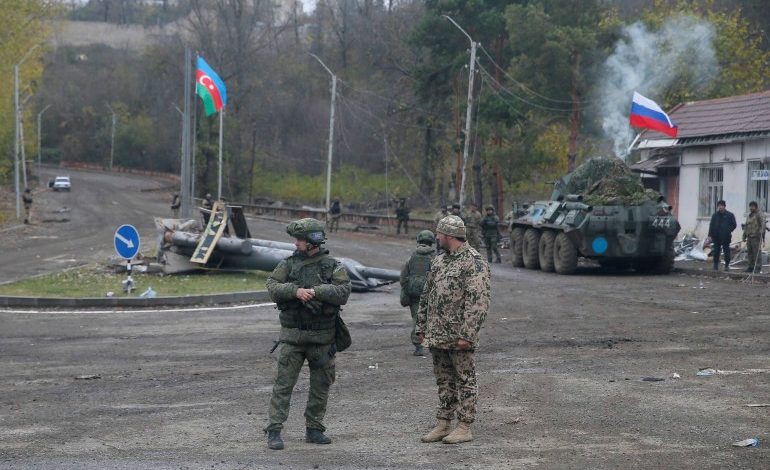Those who say, “Why not? This is, after all, on Moscow’s doorstep,” have a point. However, is it ultimately in the interest of the region? That interest might have been better championed had the US not been missing from action in the South Caucasus for the past month-and-a-half. It is now effectively shut out from the region for the next five years, perhaps longer.
The Karabakh cease-fire appears durable — no violations had occurred at the time of writing. There are powerful incentives for both sides to restrain themselves, including the presence of nearly 2,000 Russian peacekeepers, the first of which were already streaming across the Armenian border into Karabakh within hours of the deal’s announcement. A week after the signing, Russian forces had already established two dozen observation posts lining both the line of contact between Armenian and Azeri forces, and the crucial Lachin corridor that connects Karabakh and Armenia proper.
These established facts on the ground, enshrined by Russia’s presence as the sole international actor in the Armenian-Azeri agreement, leave little room for other international powers to involve themselves. The US, in particular, having been largely absent during the conflict, finds itself on the outside looking in. With two months to go until Joe Biden’s inauguration, what will the situation look like once the new US president finally enters the White House — and what options will Washington have for meaningful involvement?
On paper at least, there is significant leeway for American involvement in what comes next in Karabakh. The most intractable issue of the Karabakh dispute — the precise final status of the Armenian-populated and controlled rump territory — remains wholly unaddressed, not even mentioned in the deal signed last week. Committed US diplomacy could play a key role here. There is significant precedent for this: After all, it was in Key West, Florida, in 2001 that the two sides, represented by then-Armenian President Robert Kocharyan and Azerbaijan’s Ilham Aliyev, the current president, came as close as they ever had to a resolution.
That, however, was a long time ago. The auspices under which it occurred, meanwhile, have since become all but irrelevant. Key West was an initiative of the Organization for Security and Co-operation in Europe’s Minsk Group — a set of 11 states, headed by the troika of Russia, the US and France, which has served as the main vehicle for organizing negotiations between Armenia and Azerbaijan on the Karabakh issue.
But the Minsk Group is dead in the water. Both the Armenian and Azeri leaders have repeatedly criticized its effectiveness and relevance after 25 years without progress, and it played no substantive role in halting the recent fighting. Russia’s unilateral imposition of the present cease-fire deal and the entry of Russian forces into Karabakh show that Moscow holds the cards at present.
How, then, could the Biden administration play a constructive role in the conflict and, more importantly, attempt to counterbalance Russia’s bolstered influence in the region? Simply put, in the short term, there is little Washington can do. It had a 45-day window during the war in which it could have asserted itself as a major player, but with an election and the general state of the Trump administration more broadly, it was never going to do so.
Missing this opportunity and allowing Moscow full rein over how the war ended means Russia now sits with military bases on the territory of all three South Caucasus republics. Any US engagement with Karabakh now will thus start firmly on the back foot, beholden to this unfavorable reality on the ground.
In the near term, there is too much uncertainty to say what concrete actions Washington might be able to take to get a seat at the table. There are large sections of the current Armenia-Azerbaijan deal that need to be clarified in practice, including exact lines of control on the ground, but none of this is likely to involve Washington’s influence.
Russia’s presence as the sole international actor in the Armenian-Azeri agreement leaves little room for other international powers.
Neil Hauer
Perhaps the US could help assuage the acute political crisis Armenia itself is now entering. But this, too, will likely be resolved (or be too far gone to help) before Jan. 20.
Looking forward, the end of the five-year mandate of Russia’s peacekeeping operation in Karabakh could mark a logical date to work toward, with the US angling for a place in whatever comes next in international peacekeeping securing the region. Unfortunately for Washington, Russian peacekeepers do not tend to leave an area once they are deployed, as many in Moldova and Georgia (which have hosted Russian garrisons for 20-plus years) could tell you. It is highly unlikely Moscow’s forces, now deployed, will simply pull out of Karabakh in late 2025.
The reality is that the US has missed the boat on this conflict for the next generation. The incoming Biden administration can fiddle around the margins, playing a role in minor related issues, but Russia is now enshrined, both in law and in practice, as the international power through which Karabakh’s fate will be decided.
By this fact, Russia has cemented its primacy in the region and shut out the US. The best the next US president can hope to do in retaining American influence in the South Caucasus is to redouble efforts in Georgia, which has its own host of problems and unresolved Russian-backed conflicts. What the war between Armenia and Azerbaijan shows is that even a brief lapse in attention by Washington can have long-lasting repercussions.
































